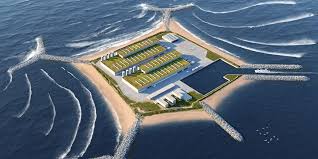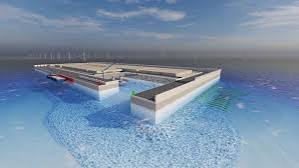Belgium looks forward to the construction of an artificial energy island halfway between wind farms on Princess Elizabeth Island.
Location
The Princess Elisabeth covers only a component of the entire Princess Elisabeth Zone which is an offshore renewable energy generating area in the North Sea.
The unit is 45 kilometers (28 miles) distant from the coast of Belgium. It is co-financed by the EU’s recovery fund from which the initiative secured a 100 million euro grant.
The platform will be an energy network at sea by which high-voltage electricity is transmitted in direct current (HVDC) and alternating current (HVAC) will be produced. The high voltage network on the island will intelligently link different energy sources to deliver power to the Princess Elisabeth Zone.
Alongside the facility, a technical prototype of hybrid interconnectors will be built, arranged to exchange energy between countries and linked to future wind energy farms in the North Sea.

Engineers plan to build the artificial energy islands using about 2,343,000 cubic meters of sand. The sea walls of the islands will be constructed of caissons.
What are the caissons?
The units are formed of concrete and each caisson that was built is 57 meters in length and 30 meters wide and high. Creating one, on the other hand, is a three-month process that is divided and spread over five stages, which each take 20 days to complete.
The most eye-catching task of them is the caisson walls construction through the slip-forming method. These walls arc up to about four inches (10 cm) per hour, and the process lasts ten days.
‘Runners’ now shift the caissons from one work to another, and it usually takes them around 6 hours just do that. Once prepared it is a great amount i.e. 22,000 tonnes.
As the caisson is prepared for storage, it will be brought to the shore by a semi-submersible vessel and put into a temporary storage spot in deep water. The caisson is facing further movement to its destination on the north sea where construction of the largest energy network system is going to be built by 2026. Thereafter, the electrical equipment installation can be commenced.
Completion date
The proposed plant is planned for completion and commissioning by the year 2030.
“The North Sea or the energy independence fountain are what we can expect to be from Princess Elisabeth Island, and our PM, Alexander De Croo, has already made a comment on his visit to the construction site,” according to the Prime Minister of Belgium, emphasizing on the importance of the energy contribution that can be expected from the North Sea in the process.
“Belgium has always been at the very front in offshore wind, and keeping up the innovations improve our status to still be at the top of the list.” – the Prime Minister end the release with these following words.
“By doing this, our Belgian companies can more easily find innovative solutions and deliver services both within as well as outside of their country, while at the same time guaranteeing a stable, affordable energy source for our people and businesses.”
Read also Infrabel announces €310 million renovation on the oldest high-speed rail in Belgium
